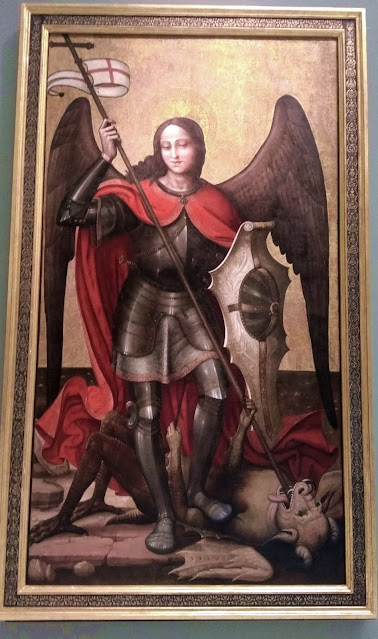The Valencia Fine Arts Museum houses some of the most important paintings in Spanish history. As soon as you enter the main gallery, a monumental painting by San Miguel Arcángel takes your breath away.
This work of art has been in the museum's collections for a long time and has been seen by many generations of Valencians and foreigners. Because of its size, it is very captivating and immediately grabs your attention. Let us take a closer look...
Article by Karla Darocas, Hons. B. A. Fine Arts (KarlaDarocas.com)
The work is by Miquel Esteve, a Spanish Renaissance painter who was active in Valencia in the first quarter of the 16th century. The painting style follows the aesthetic principles of the Italian Renaissance painters, which is not surprising since Valencia was a popular port for many Italian artists who came to the peninsula
The composition fits all the characteristics of early Renaissance art. It is perfectly balanced in the frame. The latitude line is marked in the 2/3 ratio, the golden ratio. The postures of San Miguel Arcángel are realistic. The demon on the ground is foreshortened (the artistic effect of shortening lines in a drawing to create the illusion of depth). The background is blurred with layers upon layers to create atmosphere. The lower half of the painting applies the chiaroscuro technique and gives a sense of depth
As modern as San Miguel Arcángel is in his artistic style, his place in history and the symbolism of his painting are timeless. San Miguel Arcángel stands relaxed over a demon, subduing it with little to no effort. He is a victorious soldier for his boss, God
He is depicted with a naturalistic face. His soft, almost feminine features with a perfect Roman nose, which was very popular at the time. His armour is modern with flexible joints. His smile is put on without pride, for he needs no grand gesture to celebrate his heroic deed
The demon, on the other hand, is not so handsome. His face is neither human nor animal, but something different and unknown, and the unknown is always frightening. His body parts do not match. He is obviously dead. A spear is stuck through his mouth in his head and his tongue hangs out the side.
THE ARTIST
Miquel Esteve was well known in the city of Valencia for his activism. In December 1520, he campaigned within his chapter or guild on behalf of his fellow painters in Valencia. As a trustee, he presented a document to the governor of Valencia so that his chapter could become a university.
And on 15 June 1521, together with 26 other painters, they joined the Brotherhood of Belén, a guild that masterfully created the nativity scenes, to take up arms and join the revolt of the regional artisans' guilds or Germanias (from germà, which means brother in Valencian) against the royal council, the regent, the soldiers and the regional dukes
Fortunately, during his reign, Ferdinand the Catholic granted the craftsmen of the Kingdom of Valencia the privilege of forming armies in case they had to fight the Barbary fleets. However, the guilds were eventually defeated in battle by the royal soldiers.
Read more about this conflict HERE
*******APPRECIATE ART & CULTURE * LOVE SPAIN
Resource Books written by
Karla Ingleton Darocas
and published by
SpainLifestyle.com
Resource Books written by
Karla Ingleton Darocas
and published by
SpainLifestyle.com
* CLICK HERE *




